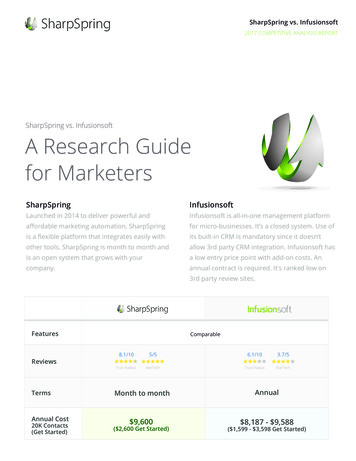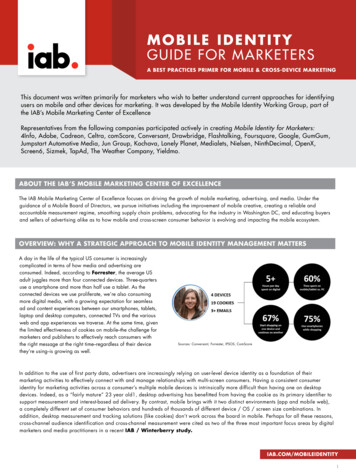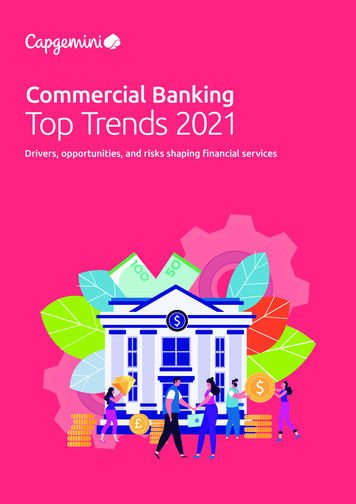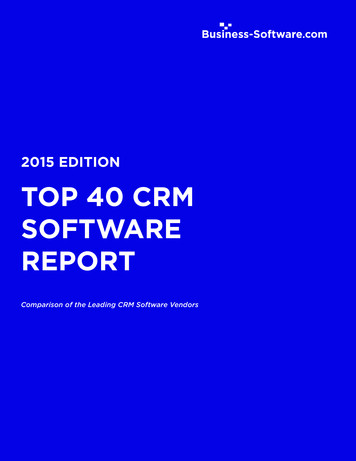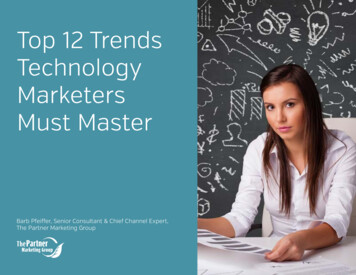
Transcription
Top 12 TrendsTechnologyMarketersMust MasterBarb Pfeiffer, Senior Consultant & Chief Channel Expert,The Partner Marketing Group
Top 12 Trends TechnologyMarketers Must MasterAs a marketer you’re always in the hot seat to know what the next “new”thing will be. There’s a constant pressure to be a step ahead and to findthat “shiny new object” that will transform your marketing and fill yourpipeline overnight.While we’ve yet to figure out how to see into the future, we do constantlymonitor the success of the full spectrum of marketing practices. We seeemerging trends in B2B marketing that we will be deploying for our clientsand offer them to help you make the most of your marketing.As you read this, you’ll see a few themes: Many trends signal the “bandwagon period is ending”. Basically, those“new” things like social marketing and content marketing are nowfirmly part of our marketing arsenal. It’s time to move beyond thebasics as those tactics mature. Many of these trends are not new marketing practices at all. Someare tactics that only larger companies could support in the past butautomation now allows small to medium technology firms to makethem work. Finally, many of the trends are focused on how marketingorganizations are changing the definition, structure and roles of theirmarketing organizations.We hope this insight into the trends will spark some ideas and helpyou answer the “what’s new” question. We are always watching fornew developments and will tell you about them on our blog and in thenewsletter. Click here to sign up for updates.
#1Content plus.We’ve spent the last two years (or more) hearing about the importance ofcontent marketing. And we’re likely to “check that box” when we post awhite paper. Now it’s time to take the next step. Savvy marketers createcontent plans first and then look at delivery vehicles (email, webinars, socialnetworks, etc.) second.There will be more content needed but also more targeted content. The bestmarketers will have content that provides something of interest for everystage of the sales cycle. And, the most likely buyer persona will be drivingeach of those stages.Marketers have to go further than just the top of funnel (where most novicecontent marketers are living today).Go Do’s: Create a content centric campaign plan withresources from The Partner Marketing Group,including a content workbook and editorialplanning calendar. Sign up for updates from the Content MarketingInstitute – the best place on the web to getinformation on content marketing trends, tips andtechniques. Commit to developing your own original contentbased on researching the specific challenges ofyour target customer.
#2Outbound still works.Despite the continued death knell for email and other outbound tactics, thetruth is they still work.Today’s marketers need to focus on creating powerful integrated campaignswith each strategy (inbound vs. outbound) doing what it does best. Inboundtactics such as social, SEO (Search Engine Optimization) and PPC (PayPer Click) will continue to lead the charge in attracting and educating newprospects while outbound will help move those prospects through the salescycle and nurture both prospects and customers. Outbound marketing willalso continue to play an integral role when approaching new markets (asyour inbound tactics gain traction).Go Do’s: If you don’t have a consistent outbound strategy,get one. Outbound includes email marketing, calldowns, events, tradeshows and yes, even directmail. If you have one, review it and “refresh” it. Needsome inspiration? Check out these ideas fromDirect Marketing News and Marketing Land.
#3The IMAGE is important!The brain processes graphics 60,000 times faster than text. That aloneshould support the need for strong images and graphics in your marketing.Add in the need to speak to short attention spans – on any device – and it’sclear that images play an important role.Design and words should work together to connect with prospects searchingfor you online. Similar to content, images (including video) will becomemore than an after-thought and will move to the center of B2B marketingmaterials.Go Do’s: MOST IMPORTANTLY, decide what you want to say FIRSTand then determine the best graphic vehicle. Look at your website – how many concepts do youhave that might be better as images (for example,methodologies)? If you are spending any time explainingan idea, a process or a system, consider developing agraphic that will catch the eye and explain the conceptmore easily. Images are magnets. Even if you don’t need a diagramor a graphic in a blog or social post, adding a compellingimage will draw the reader to the copy.
#4And the moving image.Yes – it’s another one you’ve heard before but this isn’t about creatingMORE video, it’s about creating SMARTER video. What does this mean? Likeall “shiny objects” the increased importance of video content brought us aSLEW of talking head videos filmed with a flip cam and a dull speaker or evenworse, a voiceover reading us a Microsoft PowerPoint.We see marketers using a much wider array of video tools, services andresources to create videos that educate AND entertain (or at least make uswant to watch through to the end.)Go Do’s Read this great article from the Content MarketingInstitute for the best tips we’ve seen on how,when and why to integrate video into your contentmarketing. Start with the messages you want to share andthen look at which of those will work best withvideo. Not everything is better with a movingimage. Don’t take ONE step toward video unless you havea distribution strategy too. And no – that’s not justadding it to YouTube for people to stumble across.
#5Sales and marketing teamswill align.Or die trying. According to a survey by Sirius, B2B organizations withtightly aligned sales and marketing operations achieved 24% faster threeyear revenue growth and 27% faster three-year profit growth. With therise in inbound marketing and an increase in hand-raisers (aka unqualifiedsuspects), this alignment becomes more critical.Even if your marketing and sales department is two people you should STILLhave agreement on the role, responsibilities, and requirements for each. Thebest way to align your sales and marketing teams? Create a Service LevelAgreement (SLA) and meet regularly to address any challenges.Go Do’s:Create an SLA between sales and marketing thatincludes: The number of leads marketing is responsible for. What constitutes a lead (hopefully based on a leadscoring system you set up with sales). How marketing will hand off leads to sales. How sales will return any unqualified leads tomarketing. What content (whitepapers, videos, demos, etc.)sales needs to support and accelerate the salesprocess.
#6Personalization of theprospect experience.No, not “Dear Barbara”. Rather the personalization of the entire experience.Prospects should land on a page that is specific to what they are lookingfor (think micro-sites and campaign landing pages). And follow-upcommunications should be based on the actions they take.In practical terms this means marketing automation tools that make it easyfor you to serve up information and messages based on your prospect’sresponses.Go Do’s: Automation tools such as ClickDimensions,Marketo, SalesFusion and others make it easy todeliver the important information your prospectsand customers need to make a purchase.Evaluate which one fits your needs and make theinvestment. If you’re already using these tools, make acommitment to invest in additional training to learnmore of the “features” that can help take yourmarketing up a notch.
#7The death of SEO as weknow it. Well, sort of.In October of 2013, Google released ‘Hummingbird’ and with it, a significant(but well telegraphed) change. With Hummingbird, marketers can no longersee the performance of their keywords in their Google Analytics.What does this mean to you? The same thing it always has – you need tohave high quality, original content that focuses on what you do and whatyour prospect needs as well as links to and from sites that are relevant toyour prospect.Go Do’s: Use keywords throughout all your contentincluding blogs and social media posts but usethem naturally. In the simplest terms, talk aboutthe challenges your prospects are facing and you’llget found. Read this great blog on how Hummingbird willimpact marketers.
#8And the rise of advertising.While Google has removed keywords from their analytics, they have keptthem with their paid options. This could lead the cynic to believe that thiswas done to drive advertising. Whether it was or not, it doesn’t negatethe value of online advertising. New online advertising tactics such asremarketing and LinkedIn ads give you incredible opportunities to microtarget your audiences.Go Do’s: Work with your SEO team to identify your goals andstart testing various online advertising options. Going DIY or want to have more info before youbring your team in? LinkedIn, Google and Bing haverich information on their advertising options withinfo for beginners to experts. Get specific. Look for advertising opportunitieswherever your audience hangs out. For example, ifyou cater to distributors, evaluate the advertisingoptions on Modern Distribution Management.
#9Customers move out frombehind the case studiespage.What conveys credibility faster than your customers and the results you’vehelped them achieve? Not much.Shrewd technology marketers will elevate the value of customer experiencecontent like case studies, videos, and testimonials and will invest in buildingpowerful customer reference programs to keep that content coming.Go Do’s: Add specific customer reference metrics toyour marketing plan. For example, produce onewritten or video case study per quarter (if needbe, outsource it so it gets done), two blog postsper month about a customer, and six social mediaposts.
#10Marketing jobs will change.Outsourcing continues to grow. The skills required by marketers today arevastly different than even five years ago and for the most part, not foundin a single person. Marketers today need multiple skills – from creatingcompelling content to on-line engagement, marketing automation, andmeasurement and analytics.Rather than add headcount, smart companies will use their marketing headsas “directors” – literally directing the work of both internal and outsourcedresources. Directors will be highly skilled with marketing automation andother technologies to create a personal experience that can demonstratereal ROI to the company.Go Do’s: Look at what you do well, what you have timeto do and develop a plan to outsource the rest.Not every marketer is a great writer or proficientdesigner. Outsourcing frees the marketing directorto focus on the all-up strategy. After all, it’s aboutadding revenue to the bottom line. If you do decide to outsource, find an agency withexperience in the technology industry you live andbreathe every day (ERP, CRM, Managed Services,etc.). Not only is ramp-up time reduced but you’llend up with a better product.
#11Technology firms willactually use marketingtechnology to measure ROI.In the category of the shoemaker’s children who have no shoes, technologymarketers continue to lag in their use of powerful marketing technologysolutions. Now is the time to personalize the prospect experience andeffectively convert inbound visitors. We understand that you are working withlimited resources, but automation can help you make it happen.Go Do’s:Create a TRUE dashboard (a Google Analytics report isnot a dashboard) that combines both sales and marketingmetrics. Some ideas: Lead generation against target / # of qualified leadspassed to sales. Engagement (website traffic growth, backlinks, visitduration, email metrics). Average cost of a customer acquisition and is itdecreasing or increasing?
#12Everything old is new again.Direct mail works. Events work. Before you run out and start bookingseminars again though, there’s one big change that you need to considerbefore going live. Events, direct mail, webinars, etc. MUST deliver value toyour prospects, not just to you.Think quality over quantity. For example, be topical. If there has recentlybeen a large security breach in the news (think Target stores), create a themethat addresses the fear each retailer is feeling over the hacking of customerand financial data.Go Do’s: Doing an event or webinar? Forego the stale monthly‘demo and features’ seminars of the past. Make it special.Work with a subject matter expert, for example, a datasecurity consultant, to build an agenda that will deliverreal value to your target audience. Think dimensional, compelling and personal for directmail. No postcards, no flyers. Start with personal,physically signed letters from CEO to CEO, dimensional(box, puffy envelope, tube) pieces. Follow-up with highvalue offers (such as a book or research report from athird party expert) to cut through the noise your prospectis receiving (off and online).
#13Let’s call this a baker’s dozen.With trend #13 we’ll finish off with a couple of resources you should considerintegrating into your marketing plans. SlideShare. The most overlooked B2B sharing site. If you only have two sitesyou can focus on (okay three) it’s LinkedIn, YouTube and SlideShare. WhySlideShare means business. Google . Despite past predictions (not ours by the way), Google is not dying.It’s growing. At the end of 2013, there were about 540 million users. Since younow need a Google account to post on YouTube we can expect that to growSIGNIFICANTLY in the coming years. Read more on how B2B marketers cantake advantage of this powerful network.We hope you found these predictions and “Go Do”suggestions helpful. The Partner Marketing Group helpsTechnology Service Providers and Software Vendorsbuild effective, multi-channel lead generation marketingprograms.Visit www.ThePartnerMarketingGroup.comor email us atinfo@ThePartnerMarketingGroup.comor call 605.574.9432Please contact us to discuss your strategy, content andsocial media marketing plans for the coming year.All rights reserved. Content owned by The Partner Marketing Group. 2014
Automation tools such as ClickDimensions, Marketo, SalesFusion and others make it easy to deliver the important information your prospects and customers need to make a purchase. Evaluate which one fits your needs and make the investment. If you’re already using these tools, ma

